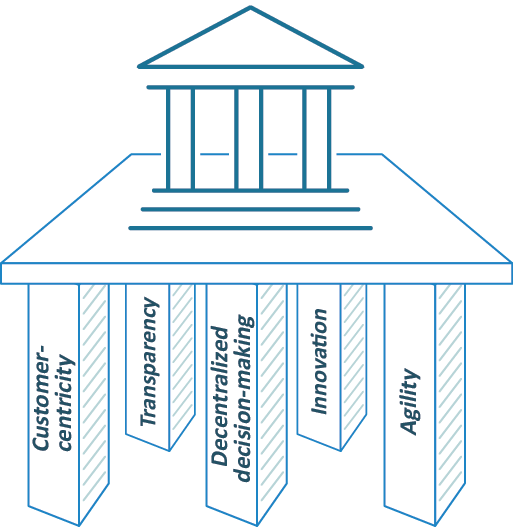BLOG. 4 min read
Is Your Cultural Foundation Strong Enough for The Disruption Ahead?
August 11, 2020 by Tracy Needham
New regulations, break-through technology, changing consumer behavior, another global pandemic—what will be the next big disruption for the asset management industry? Because there will certainly be one.
In our new "After the storm: Charting a new course through uncertainty" whitepaper, we talk about how a well-defined culture is critical to thriving amid disruption. It keeps a company united in the face of challenges, with employees aligned and working toward a common goal. And it acts as a reliable compass to guide employees’ decisions and actions, so they can accomplish their goals faster and more effectively. In fact, research shows companies with a strong culture generate four times the revenue growth of companies without one.
Every asset management firm has a culture, whether management intentionally created it or not. Leading firms know that culture starts at the top, with company leaders thoughtfully establishing the core values, communicating them clearly and repeatedly across the firm, and consistently modeling them in their own actions and behavior. Furthermore, we believe that there are five key elements that position a firm’s culture to thrive, despite the disruptions ahead:
- Customer-centricity
- Transparency
- Decentralized decision-making
- Innovation
- Agility

1.Customer-centricity
The customer experience is a vital way for firms to differentiate themselves and build long-term relationships with clients. Being customer-centric means prioritizing the sharing of customer data and insights throughout the firm so that employees can anticipate customers’ needs more accurately, and fostering a positive experience at every interaction. Employees know that they are expected to consider the impact of actions and decisions on the customer and are held accountable for customer metrics that are relevant to their areas.
Many asset managers claim to put the customer first, but they are still organized around the firm’s products and sales process—instead of the customer’s needs and journey. And they communicate with prospects and customers as if they are homogenous channels, instead of individuals with a unique set of needs, interests and preferences. For example, while the technology to deliver a more personalized experience on websites has existed for several years, just 11.1% of the 54 asset manager websites we evaluated last year were using that technology to ensure financial advisors see the most relevant content when they land on the home page. This must change for firms that want to make the customer experience a key differentiator.
2.Transparency
Transparency promotes a sense of confidence and trust among employees, as well as customers and other stakeholders. This means ensuring the company’s strategic goals, priorities and expectations are crystal clear—and translated into measurable key performance indicators (KPIs) and incentives for every unit and every employee. This promotes accountability for actions and decisions and fosters cohesion across the firm. Yet, performance-related metrics are rarely used outside of the sales department. For example, less than one-fifth of firms have KPIs related to ROI for their business intelligence teams.Transparency also means robust internal information and data flow. Just 24.2% of asset management CMOs said sales and marketing teams share an integrated view of all customer touchpoints—a must for any firm that aspires to be customer-centric. Firms must kill the information and data silos so everyone is working from the most complete and up-to-date information about the business, its customers and its products.
3.Decentralized decision-making
Markets and opportunities move quickly. Decisions must be made fast, and the conditions for those decisions are constantly evolving. A culture that democratizes decision-making enables the firm to move faster—and serve customers better—by enabling staff who are closer to the situation, such as salespeople in the field, to make data-informed decisions on the ground. A decentralized, data-driven approach also empowers employees to take greater ownership of their business area and fosters a greater sense of contribution to the firm’s goals. To do this, firms must learn to focus on acquiring the right talent and promoting a “success mindset” on the ground. Set simple parameters and principles to help employees make quick decisions, rather than focusing on perfect analyses and outcomes.
4.Innovation
Asset managers now compete with fintech firms, wealth managers and upstarts from outside the industry that are much more adept at leveraging innovation to increase efficiency, deliver a personalized customer experience and improve investment outcomes, and stand out from the crowd.
As a result, asset managers must be willing to invest where other firms are not. You cannot create a culture of innovation with occasional brainstorming sessions and idea contests. Instead, firms must broaden the concept of innovation beyond new products—encouraging employees to think creatively about ways to improve the firm’s business model, processes and policies in ways that will create value for the firm.
5.Agility
An agile culture promotes flexibility and prioritizes high-impact actions, such as taking a contrarian approach. It also promotes experimentation, encouraging employees to spend 10–15% of their time pursuing their ideas. As one executive at a mid-sized firm recently told us, they want employees to try new things and do not mind when they fail—as long as they fail fast, document the lessons and leverage them to move on.
By shoring up these five pillars of culture, asset managers will be able to better withstand whatever challenges arise in the months and years ahead. To learn more, please read our full "After the storm: Charting a new course through uncertainty" whitepaper.
Written by Tracy Needham
Sr. Business Research Analyst, Research, Analytics and Consulting






